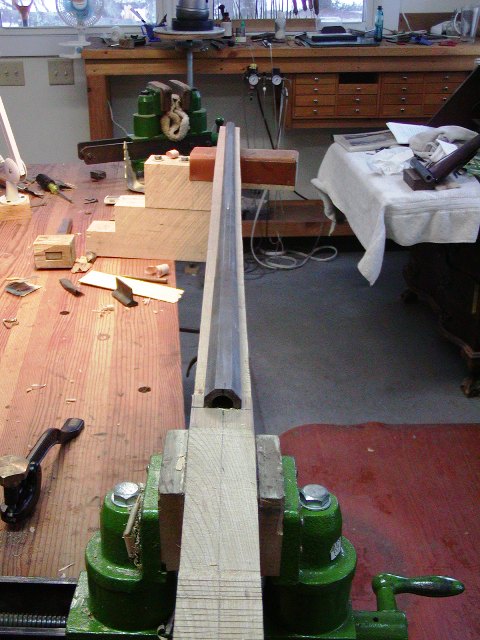- Joined
- Nov 26, 2005
- Messages
- 5,230
- Reaction score
- 10,924
Hi Folks,
I pride myself on thinking things through, measuring twice, and cutting once. However, I sometimes get complacent and lazy and I should learn to step back and stop when I feel that way. Sometimes I wish I had more discipline. I was drilling holes for barrel pins in a stock for an early pattern Brown Bess musket. I use the popular point held in the drill press vise, which requires you to locate the entry and exit holes precisely where you want them. Then you line up the drill with the tip of the point to drill a precise hole. The problem was the gimbles on one of the axes of my x-y sllde table was loose and the position of the point migrated with the vibration of the drill press. I always check these things before drilling but I got cocky and didn't. The result was a disaster for the forward pin. The hole was off so far that the drill hit the lower edge of the barrel lug and deflected down so the hole came out 3/16" below where it should, almost into the ramrod channel. I just had to laugh at my error and fix it. So I thought I would make lemonade and describe how I hide holes. Many might fill the hole with a turned piece of the same wood. In doing that you have to have the grain running the length of the plug or it will fall apart when shaping it. If you do that, the plug will take stain and oil darkly and stand out because the end grain is exposed on the surface. Instead, I cut a narrow rectangular wedge from wood with the grain running across the top of the plug. I carefully file it until it fits into the hole and then glue it in with super glue or wood glue. I make sure the grain of the wood across the top is parallel with the grain of the stock. When in place I pound the snot out of it until it is hammered into the hole. When the glue is dry, I cut and file the plug flush with the stock. Then, when I am about to stain the stock, I take a scalpel or X-acto knife and cut fine shallow lines across the top of the filled hole parallel with the grain of the stock. The hole will disappear. The hole for the rear of the trigger guard on this British carbine was plugged because the guard had to be inlet deeper after the original hole was drilled. Can you tell?

dave
I pride myself on thinking things through, measuring twice, and cutting once. However, I sometimes get complacent and lazy and I should learn to step back and stop when I feel that way. Sometimes I wish I had more discipline. I was drilling holes for barrel pins in a stock for an early pattern Brown Bess musket. I use the popular point held in the drill press vise, which requires you to locate the entry and exit holes precisely where you want them. Then you line up the drill with the tip of the point to drill a precise hole. The problem was the gimbles on one of the axes of my x-y sllde table was loose and the position of the point migrated with the vibration of the drill press. I always check these things before drilling but I got cocky and didn't. The result was a disaster for the forward pin. The hole was off so far that the drill hit the lower edge of the barrel lug and deflected down so the hole came out 3/16" below where it should, almost into the ramrod channel. I just had to laugh at my error and fix it. So I thought I would make lemonade and describe how I hide holes. Many might fill the hole with a turned piece of the same wood. In doing that you have to have the grain running the length of the plug or it will fall apart when shaping it. If you do that, the plug will take stain and oil darkly and stand out because the end grain is exposed on the surface. Instead, I cut a narrow rectangular wedge from wood with the grain running across the top of the plug. I carefully file it until it fits into the hole and then glue it in with super glue or wood glue. I make sure the grain of the wood across the top is parallel with the grain of the stock. When in place I pound the snot out of it until it is hammered into the hole. When the glue is dry, I cut and file the plug flush with the stock. Then, when I am about to stain the stock, I take a scalpel or X-acto knife and cut fine shallow lines across the top of the filled hole parallel with the grain of the stock. The hole will disappear. The hole for the rear of the trigger guard on this British carbine was plugged because the guard had to be inlet deeper after the original hole was drilled. Can you tell?

dave






